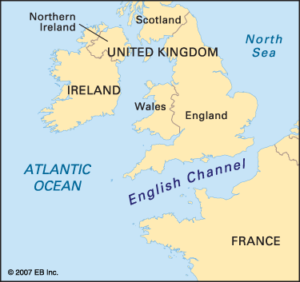In news–Recently, over 20 migrants died crossing the Channel from France to England when their boat sank off the northern port of Calais, the deadliest single disaster on the intensively-used route.
About English Channel-
- The English Channel, also called La Manche(in French) is a narrow arm of the Atlantic Ocean separating the southern coast of England from the northern coast of France.
- It also links to the southern part of the North Sea by the Strait of Dover at its northeastern end.
- With an area of some 29,000 square miles (75,000 square km), it is the smallest of the shallow seas covering the continental shelf of Europe.
- From its mouth in the North Atlantic Ocean an arbitrary limit marked by a line between the Scilly Isles and the Isle of Ushant its width gradually narrows from 180 km to a minimum of 34 km, while its average depth decreases from 400 to 150 feet (120 to 45 metres).

- It is the busiest shipping area in the world.
- Nowadays, many travellers cross beneath the English Channel using the Channel Tunnel. This engineering feat, first proposed in the early 19th century and finally realised in 1994, connects the UK and France by rail.
- It is now routine to travel between Paris, Brussels and London on the Eurostar train.
- The current English name (in general use since the early 18th century) probably derives from the designation “canal” in Dutch sea atlases of the late 16th century.
- Earlier names had included Oceanus Britannicus and the British Sea, and the French have regularly used La Manche (in reference to the sleevelike coastal outline) since the early 17th century.
Source: Hindustan Times














